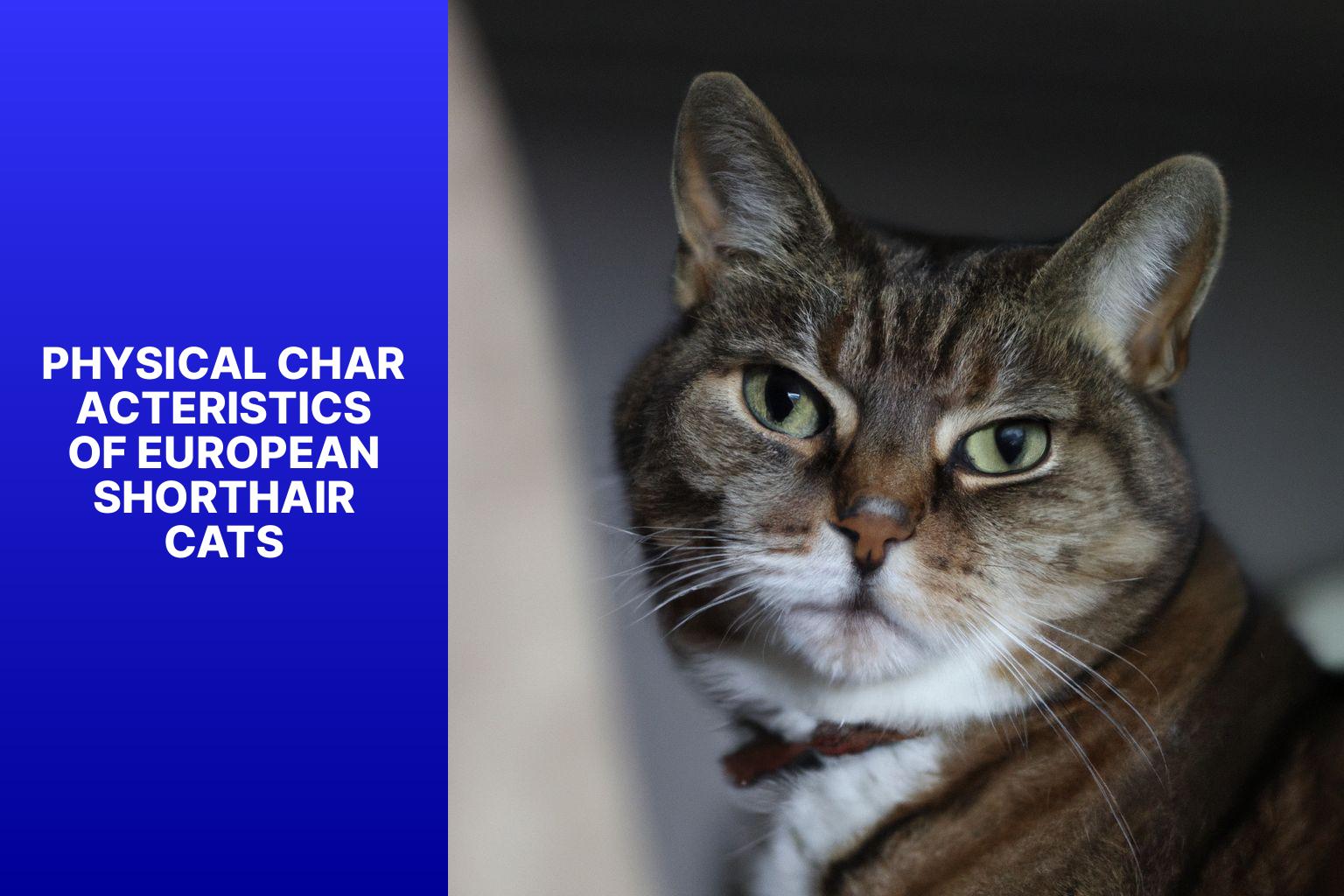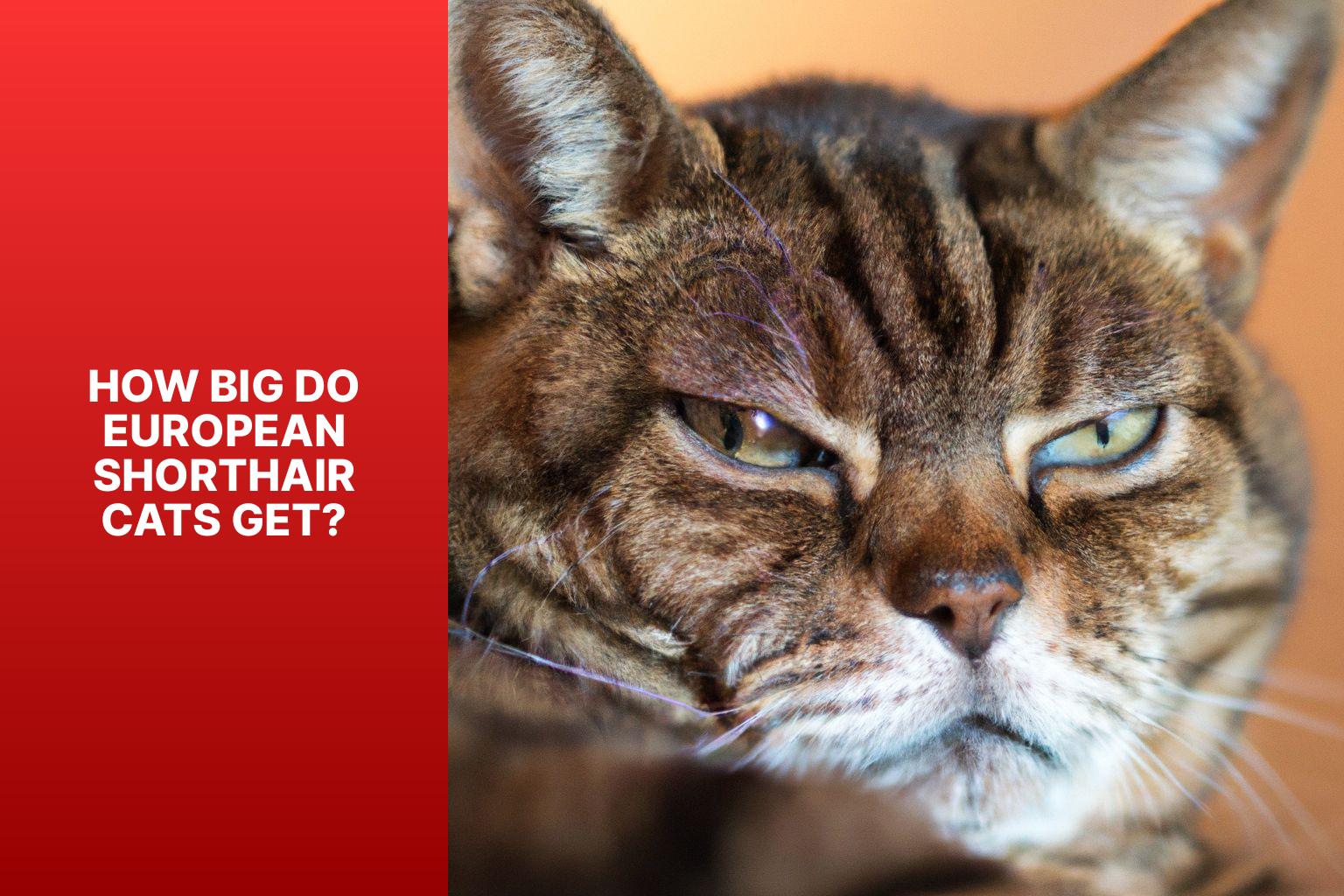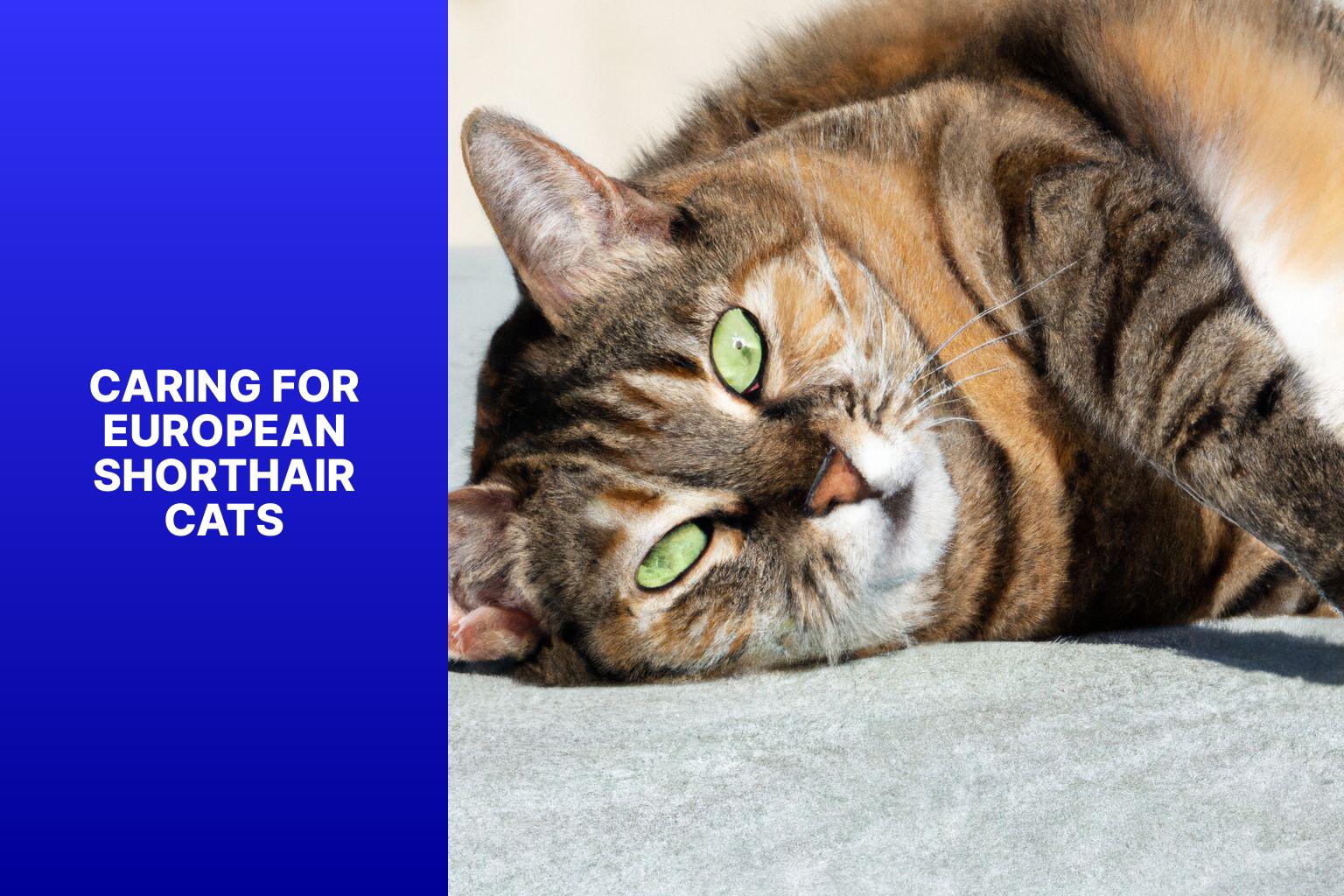European Shorthair cats are known for their unique physical characteristics and charming personalities. Understanding their size and proportions is crucial for providing proper care and meeting their specific needs.
Physical Characteristics of European Shorthair Cats
European Shorthair cats exhibit a variety of coat types and colors, which adds to their visual appeal. Their short and dense coat comes in a range of colors and patterns, including tabby, solid, tortoiseshell, and more.
In terms of body size and proportions, European Shorthair cats have a sturdy and muscular build. They have a medium to large-sized body, with a broad chest and strong legs. Their heads are round, featuring bright and expressive eyes. These cats have a balanced and agile physical structure, enabling them to move with grace and elegance.
How Big Do European Shorthair Cats Get?
When it comes to the size of European Shorthair cats, several factors influence their growth and development. These factors include genetics, diet, and overall health. It is important to note that each cat is unique and may have slight variations in size.
Generally, European Shorthair cats fall within the medium to large size range. Males tend to be larger and heavier than females, with an average weight ranging from 10 to 16 pounds (4.5 to 7.3 kg). Females, on the other hand, typically weigh between 7 to 12 pounds (3.2 to 5.4 kg).
Comparison of European Shorthair Cats with Other Breeds
When comparing European Shorthair cats with other feline breeds, it is interesting to note a few distinctions.
European Shorthair cats share similarities with Domestic Shorthair cats, as they both have sturdy builds and adaptable personalities. European Shorthairs are recognized as a specific breed with distinct characteristics.
In comparison to British Shorthair cats, European Shorthairs are generally more slender and agile. British Shorthairs are known for their round faces and stockier bodies, while European Shorthairs have a more streamlined appearance.
Caring for European Shorthair Cats
Proper care is essential in ensuring the health and well-being of European Shorthair cats. Providing a balanced diet based on their age, weight, and activity level is crucial. Regular exercise and playtime will help keep them physically and mentally stimulated. regular grooming, including brushing their coat to keep it clean and healthy, is recommended.
By understanding the physical characteristics and size of European Shorthair cats, you can better meet their needs and provide a loving and nurturing environment for these wonderful feline companions.
Key takeaway:
- European Shorthair cats come in a variety of coat types and colors.
- European Shorthair cats have a moderate body size and well-proportioned features.
- Factors like genetics and nutrition can influence the size of European Shorthair cats.
- The typical size range for European Shorthair cats is medium to large.
- European Shorthair cats can be compared to Domestic Shorthair cats and British Shorthair cats in terms of size and characteristics.
- Feeding guidelines, exercise requirements, and grooming tips are important for the well-being of European Shorthair cats.
Physical Characteristics of European Shorthair Cats
Photo Credits: Www.Catcornerblog.Com by Christian Clark
When it comes to European Shorthair cats, their physical characteristics showcase their unique beauty and charm. In this section, we will uncover the fascinating aspects of their coat type and colors, as well as explore their body size and proportions. Prepare to be amazed by the variety of coat patterns and colors these feline wonders possess, and learn how their body size and proportions contribute to their overall grace and elegance. So, let’s dive into the enchanting world of European Shorthair cats’ physical traits!
Coat Type and Color
The European Shorthair cats have a variety of coat types and colors, which contribute to their distinct appearance. These cats possess a short, dense, and sleek coat that requires minimal grooming. Their coat comes in a wide range of colors and patterns.
To provide a comprehensive understanding, check out the following table that showcases the different coat types and colors found in European Shorthair cats:
| Coat Type | Color |
|---|---|
| Tabby | Various shades of brown, gray, or black with stripes, spots, or swirls |
| Solid | One solid color, such as black, white, blue, cream, or red |
| Tortoiseshell | Patches of black and orange with some white |
| Bicolor | White combined with another color, such as black, blue, red, or cream |
| Calico | White combined with patches of black and orange |
European Shorthair cats showcase various coat colors and patterns, making each cat unique. It’s important to note that these are general categories, and individual cats may exhibit slight variations within these types.
Body Size and Proportions
The body size and proportions of European Shorthair Cats are determined by genetics, gender, age, and overall health. It is usually observed that male cats tend to be larger than females. From their initial small size as kittens, European Shorthair Cats gradually grow into their full adult size and proportions.
Proper nutrition and good health are essential factors that contribute to the overall size and proportions of these cats. Generally, European Shorthair Cats have medium-sized bodies with well-proportioned features, sturdy builds, and strong bone structures. It is important to note that there may be slight variations in body size and proportions among individual cats within the breed.
Despite these variations, European Shorthair Cats are widely recognized for their elegant appearance and balanced body structure.
How Big Do European Shorthair Cats Get?
Photo Credits: Www.Catcornerblog.Com by Jeremy Campbell
Curious about the size of European Shorthair cats? Let’s dive into what factors influence their size and explore the typical range you can expect. From genetic influences to environmental factors, we’ll uncover why these kitties come in different sizes. Whether you’re considering adopting a European Shorthair or simply intrigued by their dimensions, join us on this exploration of their growth potential. Get ready to discover fascinating insights into the varying sizes of European Shorthair cats!
Factors Affecting the Size of European Shorthair Cats
| Factor | Explanation |
| Genetics | European Shorthair cat size is primarily determined by genetics. Certain genes influence growth rate and overall size. For example, if both parents are large, the cat is more likely to be larger. |
| Nutrition | Diet and nutrition during growth stages can affect European Shorthair cat size. Balanced meals and adequate protein support healthy growth. Malnutrition or improper feeding may result in stunted growth. |
| Health and Illness | Health issues or medical conditions can impact European Shorthair cat size. Illnesses affecting growth hormones or metabolism can potentially affect overall size. Regular veterinary check-ups are important. |
| Exercise and Activity | Physical activity and exercise influence European Shorthair cat size. Regular exercise maintains a healthy weight and muscle development. Active cats have a leaner body structure compared to sedentary cats. |
| Neutering/Spaying | Neutering or spaying European Shorthair cats can impact size. Hormonal and metabolic changes from neutering or spaying can lead to weight gain or changes in body composition. |
Typical Size Range of European Shorthair Cats
European Shorthair cats come in varying sizes. To give you an idea of their general size range, refer to the table below:
| Age | Weight Range | Length Range | Height Range |
|---|---|---|---|
| Adult | 8-15 pounds | 18-22 inches | 9-12 inches |
| Kitten | 1-3 pounds | 9-12 inches | 6-8 inches |
Please note that these size ranges are approximate and may vary depending on individual cats and other factors. Consider the specific characteristics of each European Shorthair cat to determine its size.
When choosing a European Shorthair cat, consider its size to ensure it fits well in your home and lifestyle. Factors such as weight, length, and height can affect its comfort and overall well-being.
European Shorthair cats are adaptable and friendly companions, regardless of their size. Choose a European Shorthair cat that fits your home and enjoy the joy and companionship it brings into your life.
Comparison of European Shorthair Cats with Other Breeds
European Shorthair cats are in a league of their own when it comes to size, but how do they measure up against other breeds? Let’s dive into the captivating world of feline comparisons as we explore the distinctive qualities that set European Shorthair cats apart from other breeds. From their interaction with Domestic Shorthair cats to their intriguing contrast with British Shorthair felines, we’ll uncover fascinating insights that will leave cat lovers of all kinds in awe. Get ready to discover the captivating comparisons that await!
Comparison with Domestic Shorthair Cats
When comparing European Shorthair cats to Domestic Shorthair cats, several factors come into play. Here is a comparison between the two breeds:
| Factor | European Shorthair Cats | Domestic Shorthair Cats |
| Origin | Originated in Europe | Can have various origins |
| Appearance | Have standardized appearance with specific coat colors and patterns | Can have a variety of appearances, including different coat colors and patterns |
| Temperament | Known for being independent, intelligent, and adaptable | Temperament can vary widely depending on individual cats |
| Size | European Shorthair cats tend to be medium-sized with muscular builds | Domestic Shorthair cats can range in size from small to large |
| Lifespan | Typically have a lifespan of 12-16 years | Lifespan can vary, but generally similar to European Shorthair cats |
It’s important to note that while European Shorthair cats have more standardized appearances compared to Domestic Shorthair cats, individual variations exist within both breeds. When choosing a cat, it’s essential to consider factors such as temperament, size, and lifespan that are suitable for your lifestyle and preferences. Remember to prioritize adopting from reputable breeders or rescue organizations to ensure the well-being of the cats.
Comparison with British Shorthair Cats
| Aspect | European Shorthair Cats | British Shorthair Cats |
| Origin | Europe | United Kingdom |
| Coat Type | Short, dense, and plush | Short, dense, and crisp |
| Size | Medium to large-sized | Large-sized |
| Body Shape | Well-muscled and athletic | Rounded and stocky |
| Head Shape | Wedge-shaped | Rounded |
| Facial Features | Prominent cheekbones, strong chin | Full cheeks, round eyes |
| Ears | Medium-sized, wide-set | Medium-sized, wide-set |
| Eye Shape | Almond-shaped | Round |
| Temperament | Active, intelligent, and affectionate | Reserved, independent, and calm |
European Shorthair Cats and British Shorthair Cats have distinct differences. European Shorthair Cats are from Europe, while British Shorthair Cats are from the United Kingdom. Both breeds have short, dense fur, but European Shorthair Cats have a plush texture, while British Shorthair Cats have a crisp texture.
In terms of size, European Shorthair Cats are medium to large-sized, whereas British Shorthair Cats are generally larger. European Shorthair Cats have a well-muscled and athletic body shape, while British Shorthair Cats have a rounded and stocky body shape. European Shorthair Cats have a wedge-shaped head, prominent cheekbones, and a strong chin, while British Shorthair Cats have a rounded head, full cheeks, and round eyes.
European Shorthair Cats are known to be active, intelligent, and affectionate, while British Shorthair Cats tend to be more reserved, independent, and calm. It’s important to consider these differences when choosing between the two breeds. Make sure their characteristics align with your preferences and lifestyle.
Caring for European Shorthair Cats
Photo Credits: Www.Catcornerblog.Com by Jeremy Harris
Caring for European Shorthair Cats is all about ensuring their well-being and happiness. From feeding and nutrition guidelines to exercise and activity requirements, as well as grooming tips, this section covers everything you need to know to provide the best care for your European Shorthair furry friend. Let’s dive into the ways to nourish their bodies, keep them active, and maintain their beautiful fur, so they can thrive and bring joy to your life!
Feeding and Nutrition Guidelines
To maintain the health and well-being of European Shorthair cats, it is important to provide them with a balanced and nutritious diet.
1. Balanced Diet
European Shorthair cats require a diet that includes proteins, carbohydrates, and fats. High-quality cat food formulated for their nutritional needs should be given.
2. Portion Control
Controlling meal portions prevents overfeeding and obesity. Use feeding guidelines on cat food packaging to determine the appropriate amount based on weight and activity level.
3. Fresh Water
Always provide fresh and clean water to keep your European Shorthair cat hydrated and prevent urinary tract issues.
4. Avoid Human Food
Do not feed cats human food as certain ingredients can be harmful. Stick to balanced and complete cat food recommended by veterinarians.
5. Regular Vet Check-ups
Regular visits to the veterinarian are important for monitoring overall health and nutritional requirements. They can provide guidance on the best cat food brands and necessary dietary supplements.
Exercise and Activity Requirements
European Shorthair cats have specific exercise and activity requirements for their overall well-being.
To keep them healthy, maintain a healthy weight, and prevent obesity, European Shorthair cats need regular exercise. Playtime and interactive toys can help keep them active and stimulated.
Both indoor and outdoor exercise options are available for European Shorthair cats, but safety is important. If allowing outdoor access, ensure a secure area free from hazards. Indoor exercise options include climbing trees, scratching posts, and interactive toys.
Mental stimulation is essential for European Shorthair cats. Puzzle toys, hiding treats, and teaching them tricks can provide mental exercise. It is just as important as physical exercise for their overall well-being.
Interacting and playing with your European Shorthair cat strengthens the bond between you and provides the exercise and activity they need. Set aside dedicated playtime each day for interactive play sessions.
Creating a stimulating environment benefits European Shorthair cats. Cat trees, scratching posts, and hiding spots encourage exploration and engage in natural behaviors like climbing and scratching.
Understanding and meeting the exercise and activity requirements of European Shorthair cats is crucial to ensure they remain happy, healthy, and fulfilled companions.
Grooming Tips for European Shorthair Cats
Grooming plays a vital role in the maintenance of European Shorthair cats. To ensure their well-being, here are some essential tips to keep in mind:
1. Regularly brush their coat to eliminate loose hairs and prevent matting. Opt for a soft-bristled brush or a grooming mitt.
2. Trim their nails on a regular basis to prevent them from growing too long or becoming sharp. You can either use cat nail clippers or seek professional assistance.
3. Gently clean their ears with a damp cotton ball or a specially formulated ear cleaner. It is crucial to avoid using cotton swabs to prevent any potential injury.
4. Routinely check their teeth and gums, and brush their teeth with cat-specific toothbrush and toothpaste.
5. Occasionally bathe them using cat-friendly shampoo and warm water. Ensure thorough rinsing to completely remove all traces of shampoo.
6. Keep an eye out for any discharge or signs of irritation in their eyes. If needed, gently clean their eyes with a damp cloth or consult a veterinarian for proper medical attention.
7. Stay attentive to their overall health. Regular veterinary check-ups can help identify any grooming issues or concerns.
Pro-tip: Transform grooming into a positive and enjoyable experience for your European Shorthair cat. Utilize treats and praises, and take breaks when necessary to alleviate any stress they may experience.
Some Facts About How Big Do European Shorthair Cats Get:
- ✅ European Shorthair cats can reach a size of 8-15 pounds.
- ✅ They have a medium-sized body structure, with harmonious and supple features.
- ✅ The head of a European Shorthair is rounded and slightly longer than it is wide.
- ✅ They have medium-sized legs, round paws, and a medium-length tail.
- ✅ The average lifespan of European Shorthair cats is 14 years, with indoor cats living longer.








